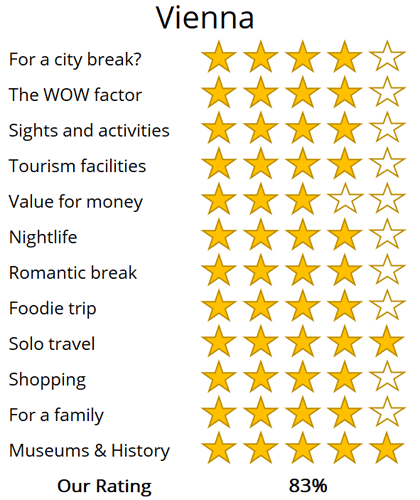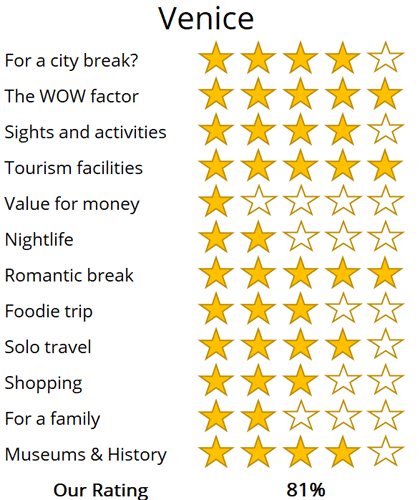WhereToGoForMyHoliday.com
The best destination comparison site!
WhereToGoForMyHoliday.com
The best destination comparison site!
Vienna or Venice, which is better for your holiday in 2024?
Vienna and Venice both offer unique and enticing experiences, but which one should you choose for your city break or holiday?
We understand your dilemma. There is an abundance of travel guides for both cities, but few actually comparing them, and advising you which is the better for your trip.
This article will provide our unbiased and independent views of Venice and Vienna, hopefully making your choice that little easier.
The article is structured into several sections, each of which can be directly accessed through the following links:
• Introduction to the cities
• Scores and ratings
• Which one should I, friends, or family visit?
• When to visit and weather
• Who is the city suited for?
• The perfect 48hours (with map)
• Tourism details (where to stay? airport details?)
Introduction to Vienna and Venice
The erstwhile epicentre of the great Habsburg empire, Vienna, is just as grand and glorious as you might expect. The Hofburg palace spreads is vast Baroque wings in the heart of the town, framing manicured gardens topped with equestrian statues.
There's the Belvedere, a patchwork of orangeries and old court rooms. There are opera houses and theatre rooms and the elegant façades of the Schönbrunn. It's enough to keep the camera a-clicking for several days.
But Vienna isn't only about 18th-centry grandeur. This is a lived-in European capital. It's got gritty nightlife districts that offer up beating boat bars on the Danube. It's got handsome parks packed with pine forests and duck ponds. There are vibrant markets with food from all around the globe. And you've got one of the world's most active café cultures, with coffee shops where the likes of Freud and Trotsky were once regulars.
Ah, Venice – a bucket-list city if there ever was one! Famed for its myriad canals, vast plazas and grand churches, this is one of Italy's most visited destinations.
Once the epicentre of its own trading empire that stretched right across the Mediterranean and even east to the Old Silk Road, it became rich on spices, precious metals, and cloth. These days, relics of that golden age remain. See them rise with the Orientalist spires of Saint Mark's Basilica. See them in the opulent interiors of the endless Doge's Palace.
But Venice is still a thriving town, not just a museum piece. Ferry boats weave through the Grand Canal and under arches where Canaletto and Monet once painted. Ice-cream parlours spill onto the narrow streets of Cannaregio. Pizzerias meet buzzy student bars scented with grappa around the Campo Santa Margherita. Yep, there's oodles of life left in this old seafaring dame!
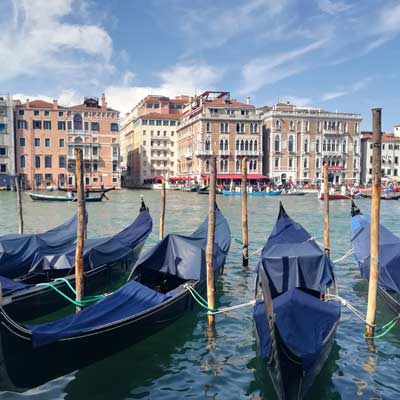
Grand Canal and gondolas waiting for the rush of tourists

The classic skyline view of Vienna from Saint Stephen’s Cathedral, with its uniquely tiled roof
Vienna vs Venice: City Ratings
Summary
Where would I journey for a personal escape? Vienna
Where would I send my parents for a memorable visit?
Vienna
Where's the ideal destination for my adventurous 19-year-old cousin?
Vienna
Where should my food-obsessed friend indulge their culinary passions?
Vienna
Note: The above comparisons are weather-independent and are based on travel during the most opportune times of the year. Details about the ideal travel seasons are elaborated upon later in this article.
In the sections that follow, you'll find a comprehensive comparison between these two fascinating cities. This includes recommendations on the duration of stay, the best times to visit, and tailored 48-hour itineraries for each city.
The final segment delves into practicalities for your travels, such as the best airport to fly into, the optimal districts for your accommodation, and insider tips, for when you come to explore the city.
We hope that you find all of this information useful, in planning your next exciting trip!
Destination details
How long to spend each city?
It's no secret that most people whiz in and out of Venice on big cruise ships, even if recent regulations are bringing a slow end to that.
Lots of weekenders also come on low-cost flights – Venice's Treviso Airport is a major hub for budget airlines like Ryanair and Easyjet. Those sorts of travellers can only ever really expect to scratch the surface of what's on offer.
The upshot? If you really want to explore this amazing city, you're going to need a little longer. If the budget allows, a week is perfect. That will be enough to see the mainstay sights, but also venture across to Murano and the Venice Lido, the party bars of Campo Santa Margherita, and the pathways of Giudecca.
Vienna is big and brimmingwith sights. History buffs and culture vultures will want at least three or four days to check off the bucket-list attractions. That's because the mainstay palaces and the most immersive museums each deserve at least half a day to themselves. You'll also need some time to wander the Old Town area and hop the famous Viennese cafés.
If you're eager to explore all of the facets of Vienna, then you'll certainly need much longer than just your average city break. Whole weeks can be spent enjoying the buzzy squares and the statue-filled parklands. What's more, there are day trips aplenty in the region, ranging from the pine forests of the Wienerwald to the rising foothills of the Salzburger Alps.

The Arsnal was the shipyard of Venice, which at its height could construct a boat in a single day

The Schönbrunn Palace, Vienna one of the grandest palaces of central Europe
Vienna in the summer can't be beaten. When the sun shines, the city's parks and bars come alive. The best weather is usually between June and August, but beware that things can get hot and humid, with temperatures cranking up over 30 Celsius. The good news is that there are some strands and swimming spots along the Danube for cooling off. If you prefer things a little milder, May and September are usually also dry and warm.
On the flip side, Vienna in winter is a real wonderland. The Austrian capital hosts some of the most enchanting Christmas markets in Europe. You'll find those brewing up hot chocolates and mulled wine on Rathausplatz and in the grounds of the Schloss Schönbrunn. They get into full swing in December, when it's common to get dustings of snow and sub-zero temperatures – boots and woollies will be required.
We're almost tempted to say forget Venice in the summer entirely. During the Italian high season between May and August, the whole place is packed to bursting with tourists. You can barely swing a slice of pizza on the Rialto Bridge or down on Piazza San Marco.
What's more, the horizon is tainted with the outlines of huge cruise ships.
Far better are the shoulder months of May and September. The crowds diminish considerably during those, but the weather still tends to be reasonable – think daytime temperatures regularly hitting the mid-20s.
The final weeks of February are also popular on account of the centuries-old tradition of the Venice Carnivale. Come then to join the revelry but be sure to bring along a flamboyant face mask (a must) and a good coat, because the winters can be cold.
It's probably a good idea to avoid the rest of the winter. Venice is one of the lowest-lying cities in the world, so flooding comes easy. In the last few years, there have been huge problems with water clogging up even the famous tourist hotspots around Piazza San Marco.
Venice is a perfect break for those keen to check off another bucket-list city. Yes, it might be over touristed, but there's still something truly magical about the canals and the gondolas and the great churches here.
It's simply unlike anywhere else on the planet. All that adds an edge of romance to boot. So, consider this one if you're searching for a city-based honeymoon.
On the flip side, Venice isn't for the budget traveller or the outdoorsy person. Yes, you can hop on a bus to go north to the Dolomites, but they are still several hours away.
There are beaches, but they are nowhere near the best on the Italian east coast. And you can expect to pay over the odds for virtually everything, from hotels to ice creams to pizza.
Packing in handsome palaces, Austrian beer houses, Alpine forests, cool cafés, art-filled galleries, and a buzzy nightlife, Vienna satisfies all sorts of travelers. You can easily fill whole trips in the museums alone. Days can be whiled away flitting between coffee shops. Nights can be spent in opera shows or glugging frothy beers in hipster bars.
Don't go thinking that Vienna is the great Austrian outdoors. This might be the country of the Alps, but the mountains are still at least an hour's train ride to the west. What's more, there's not a beach in sight. The best that landlocked Central Europe can offer in the way of sand and water is a few artificial swimming areas along the River Danube.

The cascade fountain at the Belvedere, Vienna
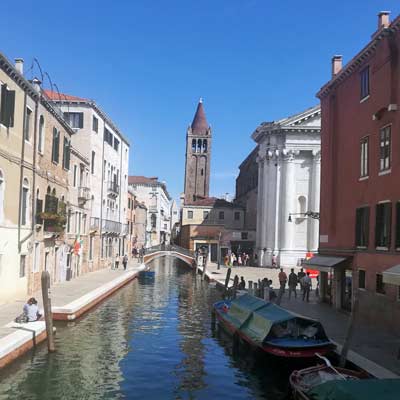
The pretty Ponte dei Sospiri and canals of Venice
48hours in Vienna
So, you only have two days in the Austrian capital? Get ready for an itinerary that's packed to bursting with all sorts. From Neo-Classical Habsburg mansions to strolls on the Danube canals to mornings in buzzy market areas, there's something for a whole host of traveler types in these parts.
Day 1: Morning on the Heldenplatz. This manicured urban garden is one of the most iconic squares in Vienna. The huge equestrian statue of Archduke Charles of Austria is what will probably catch the eye but remember that the plaza was also the place where Hitler announced the annexation of Austria in 1938. Nearby, the Hofburg stands proud.
On a quick, two-day itinerary, it's probably best not to delve inside. The exhibits can easily take hours on end, though it's a must if you're a lover of 18th-century European history. Take your photos of the mighty Neo-Classical exterior and then move straight to the streets to the west. They herald the Innere Stadt (the Old Town) of Vienna. Cobbled lanes and little archways form a maze here that's lovely to get lost in. A lunch stop (read: strudel stop) at Café Central is a doozy. Gold-leafed ceilings and elegant royal portraits gild the interior, though the main draw is sitting where Freud and Trotsky once sat sipping their coffees.
Later on, head north around the ring roads to the Sigmund Freud Museum. It's a fine introduction to the life and works of the founder of psychoanalysis, with the original doctor's couch that his patients would sit on. Beeline straight to Prater when the evening closes in. You can get there on the underground, emerging into Vienna's famous inner-city theme part with its twirling Ferris wheel and fairground attractions.

The Prater amusement park with its traditional rides and the Wiener Riesenrad Ferris wheel
Day 2: The early hours on the Naschmarkt offer some of the best people watching in the city. Fruit sellers call out prices while locals chow down on pretzels and white beer in the stalls. This vibrant bazaar is also the perfect place to grab any Viennese souvenirs and foodstuffs. A ubiquitous fix of palaces comes next. We'd recommend choosing one of the big two – the Belvedere Palace or the Schönbrunn. Both are stunning but the former is the easiest to get to. Both will also likely take a couple of hours, especially if you want to explore the sprawling grounds as well as the interior court rooms of the old Habsburg elite.
That will still leave some time in the afternoon to breeze over to the Danube Canal. Abuzz with boat bars and hole-in-the-wall eateries, it can help balance out the culture with a little hedonism. The district of Leopoldstadt is right behind, replete with hipster coffee joints and cocktail emporiums. An alternative way to cap off your weekend could be a jaunt to the hills of the Vienna Woods (the Wienerwald). They offer lookouts – and gorgeous sunsets – above the capital just behind the area of Hütteldorf.

Vienna is not just historic relic, there are modern curiosities such as the Hundertwasser House, designed by an artist who wished no straight lines in his building......
48hours in Venice
Delve into the secrets and the uber-famous sights of Venice with this 48-hour itinerary. It will take you from the legendary walks of the Rialto Bridge all the way to the hidden glass workshops of Murano, revealing some of the most enthralling corners of the iconic City of Canals.
Day 1: Rise early and race to the Piazza San Marco. Beating the crowds to the vast plaza is a great way to see it in all its glory. As the sun rises, watch as the light caresses the red-brick Campanile (a 98-meter belfry dating from the 12th century) and the bulbous domes of St Marks Basilica.
If you've managed to arrive before the queues start to form, be sure to duck into the latter. It's free to enter and has intricate Byzantine apses and frescos. Right next door is the Doge's Palace. Again, if it's too late you can certainly expect a queue. If not, head behind the Gothic frontispiece to wander the old palace of the erstwhile leaders of the Venetian republic.
Then head north through the narrow alleys of the San Marco district. It's a beautiful maze of little side streets, occasionally punctuated by a watery canal. You're sure to find a cafeteria there for lunch, before you go straight for the Rialto Bridge, made famous by Shakespeare and painters. Cross it and hit the buzzing markets of Ruga dei Oresi, which abut the small Campo Bella Vienna, a top spot to sit with a cold beer and watch elegant Venetian gondolas drift in and out of the canals.
If you choose not to ride one, you can push on to see the San Giacomo di Rialto (probably the oldest church in the whole city!) and then the neighbourhood around Campo Santa Margherita. That's a nightlife mecca, where you can unwind with a prosecco or ten.
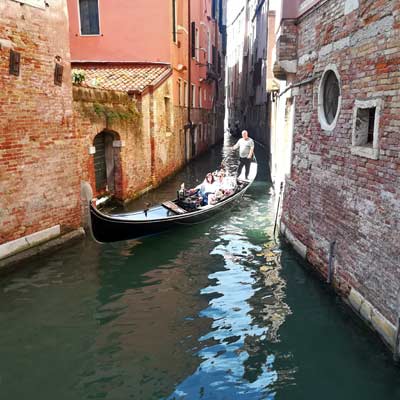
No trip to Venice is complete without a gondolas ride
Day 2: Your second 24 hours in Venice is all about hitting the different districts. We'd recommend starting on the northern side of the archipelago. That's home to characterful Cannaregio; the old Jewish Quarter. These days, it's got canal-side cafés next to the fascinating Muso Ebraico di Venezia, which tells the story of Venetian Jews over the centuries.
From there, move west to Santa Croce. Within, you'll glimpse the lived-in city. It's the only place where cars can travel on the archipelago and it has newer churches and loads of bakeries and shops. Hop the Grand Canal ferry (number 3) from there to Murano.
Pastel-painted workshops meet the water on that island, in an area that's been famed for centuries for its glass making. If you're interested, the Museum of Glass is a great place to start.
Alternatively, enjoy a lunch on the lagoon and then get back on the boat, travelling all the way through the Grand Canal to the Dorsoduro. The zone has beautiful broadside views of Piazza San Marco at sunset. It's also home to plenty of lovely osterias with northern Italian wines and delicacies to get stuck into.
Related articles: 48-hours in Venice

The vaporetti ferries are the best way to get a waterside view of Venice
Venice is largely safe and easy to travel. However, there are some things worth knowing before you go. First off, the overload of tourists has seen a huge spike in pickpockets over the years. So, always keep an eye on your valuables, especially in uber-popular spots like the Piazza San Marco and Erbaria.
Second, be wary that Venice's side streets are rarely empty. You'll always need to dodge a crowd and watch where you're walking. When it rains, flooding is common, so pack waterproofs and wellies if you're visiting in the winter months. Also, keep an eye out for pigeons. They're a nuisance on the piazzas and can even carry disease.
Navigating Venice isn't like navigating any other place in Europe. Taxis and buses simply don't exist – there are no real roads here, after all. Instead, you can make use of the ferries (known locally as vaporetti).
They run routes up and down the Grand Canal and out to other islands like Murano all throughout the day. They're actually a great way to see the main sights, with tickets for a full 24 hours costing as little as €20.

Rarely will you find a steet this quiet in Venice……
There are two airports serving Venice and its region. The largest and the closest to town is the international hub at Marco Polo Airport. That's got connections going all around the world. It's linked to the city by the ATVO bus (arrives at Piazzale Roma) and to the train station in Mestre.
If you're flying low-cost, it's more likely you'll arrive at Treviso Airport. That sits some 20 miles to the north, with buses that link to the archipelago in around 70 minutes for about €10 each way.
Choosing where to stay in Venice is very important. Fly-in, fly-out tourists will want to be in the vicinity of Piazza San Marco. The area is laced with expensive and classy hotels, but also has some more affordable options, all within walking distance of the top sights.
If to save some cash and get somewhere a little quieter, you could sleep closer to Dorsoduro or the Cannaregio, or even out in Murano. The cheapest places of all will be on the mainland, in Mestre.
Related articles: Where to stay in Venice?
Vienna is among the safest and most liveable cities in the world – at least if the stats are to be believed. Of course, you'll need to have your wits about you as if you were traveling anywhere. Pickpocketing, fake tour guides, and taxi scams do occur, though they aren't common as in other European capitals.
Getting around should be a cinch in the Austrian capital. The U-Bahn is ridiculously efficient. It links with above-ground rail lines and trams on a single-ticket network to make going from A to B a pleasure, not a chore.
Single trip fares sit at €2.40, while a 48-hour travel card costs €14.10. Don't be tempted to ride the subway without buying tickets. This is possible because the platforms aren't gated, but there are regular checks and hefty fines to match.

The Gloriette is situated on one of the highest points of Vienna and provides one of the best views of the city and the Schönbrunn Palace.
The best arrival point for those flying is Vienna International Airport. It's a well-equipped, modern port on the south-eastern side of the capital. Direct S-Bahn trains link the centre to the terminals, or you can hop on the premium Railjet from Vienna Hauptbahnhof. There's also a shuttle link provided by AirportLines Bus, costing €13 per person, return.
Picking hotels in Vienna can sometimes be a tricky business. First-time visitors can't go wrong if they aim to stay in the Old Town (the Innere Stadt), but rooms there can be pricy and sell out fast. Good alternatives include the hip and happening district of Leopoldstadt (great for dining with a youthful vibe) and any of the blocks that come off Naschmarkt.

oh we were stuck in the airport!

Copenhagen was a bit expensive...

All we did was drink beer in Brussels...

Muncih was crazy

And we got so burnt!

Remeber that night in Rome

oh we were stuck in the airport

So much fun kayaking

Berlin and that group from Austria!

There was such a view from that church

And we got so burnt!

Munich was eventful, wasn't it!

Such a view from that cathedral in Florence

Lisbon was such so much fun

Last summer was so much fun .... x

Remeber that night in Rome

Lisbon was such so much fun

Such a view from that cathedral in Florence

Munich was eventful, wasn't it!

And we got so burnt!

Remeber that night in Rome

All we did was drink beer in Brussels...

Berlin and that group from Austria!

Can't wait to go back to Dubrovnik

Remember that boat ride in Prague

Copenhagen was a bit expensive...
